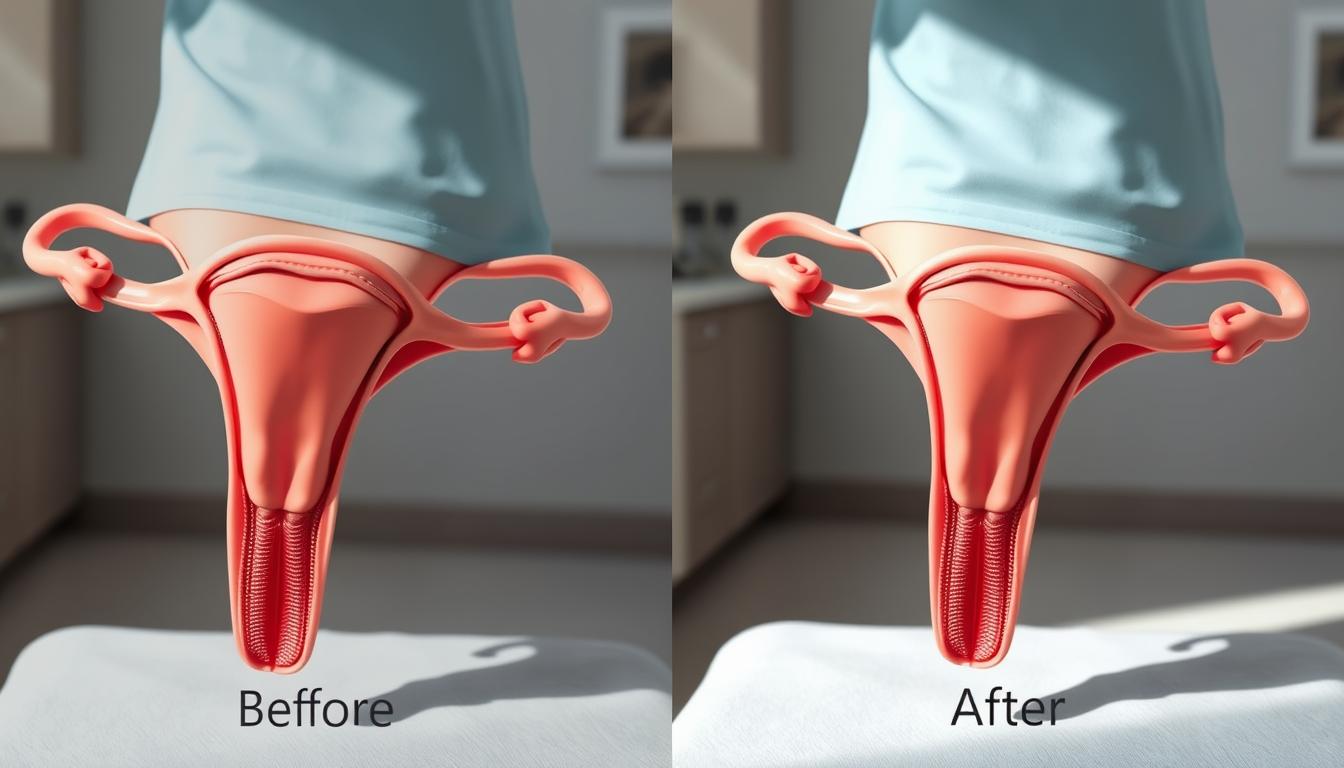Labiaplasty Before and Afters: Real Results Revealed

Did you know nearly 30% of women consider labiaplasty for cosmetic surgery? This shows the growing interest in this procedure. It aims to improve looks and comfort. We’ll look at labiaplasty results, showing how it changes lives.
Real stories and expert views will highlight the labiaplasty transformation. These stories show how labiaplasty affects more than just looks. Join us to see the before and afters that boost women’s self-confidence.
Table of Contents
What is Labiaplasty?
Labiaplasty is a surgery that changes the size and shape of the labia. It aims to improve comfort and look. Many choose it to feel better during activities like cycling or sex.
Defining Labiaplasty
The labiaplasty definition includes different methods. The most common are the trim and wedge. These labiaplasty methods remove extra tissue or reshape the labia. Over 90% of patients are very happy with the results.
Surgical Techniques Involved
Surgeons use many labiaplasty surgical techniques based on each patient’s needs. The surgery usually takes about 1.5 hours. Patients can choose local anesthesia with sedation or general anesthesia.
The trim procedure is the most common. But, the wedge technique is also favored by some surgeons. Swelling can last up to six months.
Understanding the Anatomy
It’s important to know about labia anatomy and female genital anatomy. Size and shape differences are normal. They affect how comfortable and attractive someone feels.
Understanding what’s normal helps set realistic goals for labiaplasty. This makes the journey easier.
Who Needs Labiaplasty?
Figuring out who might need labiaplasty involves looking at personal and medical factors. Women might choose labiaplasty for reasons like physical discomfort, wanting a certain look, or for their overall health. Knowing why people get labiaplasty can help them decide if it’s right for them.
Common Reasons for Seeking Labiaplasty
Many women get labiaplasty for reasons beyond just looks. Some common reasons include:
- Feeling uncomfortable during activities like exercise or cycling
- Experiencing pain or discomfort during intimacy, like feeling tugged or in pain
- Feeling self-conscious about the size or shape of their labia, especially when wearing tight clothes
Most women feel self-conscious about their labia, with 94% worried about how they look. This can hurt their self-esteem and how they feel about intimacy.
Who is a Good Candidate?
Finding out if you’re a good candidate for labiaplasty involves a detailed check-up. Good candidates usually have:
- No health issues that would make the procedure risky
- Realistic hopes about what the surgery can do
- Discomfort because of their labia’s size or shape
This careful check ensures candidates know what they’re getting into. It helps them choose what’s best for their needs and life.
Psychological Benefits of Labiaplasty
Studies show labiaplasty has big psychological benefits. Most patients feel more confident, with 87% saying they feel better about themselves after the surgery. This can lead to better body image and emotional health, improving life in many ways:
- Better sex and intimacy
- More comfort in what they wear
- Feeling more confident in social situations
In short, labiaplasty can make life better by boosting emotional and physical health.
The Labiaplasty Procedure
The labiaplasty procedure is a big step for many. It helps address concerns about the genitalia. Knowing the steps can make the experience better and set clear expectations.
First, patients get a consultation. This helps them understand how labiaplasty works. They learn about pre-operative checks and care plans.
Step-by-Step Overview
The labiaplasty procedure has a clear plan. Here are the main steps:
- Consultation: Talk about concerns, what you hope to achieve, and your medical history.
- Pre-Operative Preparations: Do tests and follow advice on medications.
- Anesthesia Administration: Choose how you’ll be numbed, like local with sedation or general anesthesia.
- Surgery: Have the procedure done using techniques like wedge or trim.
- Post-Operative Care: Follow recovery steps and manage pain and swelling.
Anesthesia Options
Anesthesia is key for comfort during labiaplasty. There are two main options:
- Local Anesthesia with Sedation: Good for outpatient procedures, leading to quicker recovery.
- General Anesthesia: For more complex cases or if you want to be completely asleep during surgery.
Duration of the Procedure
The surgery usually takes about an hour. The whole process, from start to finish, depends on many factors. The surgery itself, plus preparation and recovery, can take several hours.
After surgery, you can go back to work in a week. But, full recovery might take two to six weeks. This varies based on how quickly you heal.
For those interested in how sexuality and aging connect, check out resources on sexual health and aging. They offer important insights.
Pre-Treatment Care
Getting ready for labiaplasty means taking a few important steps. The first labiaplasty consultation is key. It helps the surgeon understand what you need and what you expect. This makes sure the surgery is just right for you.
Initial Consultation and Assessment
At the pre-op assessment, you talk a lot about what you want and what might happen. It’s a chance to share any worries you have. This makes you feel more at ease and sure about your choice.
Necessary Tests and Preparations
Before surgery, you’ll do some labiaplasty pre-operative tests. These might include blood tests and scans. Quitting smoking is also important for healing. These steps help you get ready for the surgery and recovery.
Guidelines for Medication and Supplements
It’s important to know which medications to avoid before labiaplasty. Stay away from blood thinners and some anti-inflammatory drugs. They can make bleeding more likely. Also, check your supplements to make sure they won’t interfere with healing. Knowing this helps you get ready and avoid problems.
| Medications to Avoid | Reason for Avoidance |
|---|---|
| Aspirin | Increases bleeding risk |
| Ibuprofen | Can affect clotting |
| Vitamin E | May increase bleeding |
| Herbal Supplements | Unpredictable effects on surgery |
Getting ready for surgery is all about preparation. You can learn more about health by checking nitric oxide benefits. This shows how important it is to take care of your health before surgery.
Before and After Treatment Pictures
Looking at labiaplasty before and after photos is key for those thinking about it. These pictures show what results are possible. They also share how the surgery can change a person’s confidence and how they feel about themselves.
Real Patient Experiences
Many patients are happy with their labiaplasty results. Their stories show how the surgery can really improve their lives. They talk about feeling more in control and comfortable in their own skin.
Factors Affecting Results
Several things can change how well labiaplasty works. Knowing what affects the outcome is important. The surgery method and each person’s body are big factors. How well you take care of yourself after surgery also matters a lot.
Managing Expectations
It’s important to know what to expect before getting surgery. Talking openly with your doctor about what you hope for helps. Everyone’s experience is different, so it’s good to learn as much as you can. You can find helpful information at sites about sexual health and satisfaction.
| Factors Influencing Results | Description |
|---|---|
| Surgical Technique | Variations in techniques can alter aesthetic outcomes. |
| Individual Anatomy | Each person’s unique biological factors affect the response to surgery. |
| Post-Operative Care | Proper care significantly influences recovery and long-term results. |
| Patient Expectations | Realistic discussions about outcomes lead to higher satisfaction levels. |
Post-Treatment Care
After labiaplasty, it’s key to follow the right aftercare steps. This helps manage pain, aids in healing, and keeps an eye out for any issues. These steps are crucial for a smooth recovery.
Immediate Aftercare Instructions
Right after the surgery, start with these steps:
- Maintain cleanliness: Clean the area gently with mild soap and water. Stay away from harsh soaps.
- Use absorbent pads: You might see some bleeding or spotting, so have pads ready.
- Follow prescribed medications: Take the pain meds as told to help with discomfort.
- Rest is key: Don’t overdo it physically, let your body heal.
Recommended Activities and Restrictions
Choosing the right activities after surgery is important. Here’s what to do:
- Resume work: You can go back to work and light activities in 1–2 weeks.
- Avoid vigorous exercise: Don’t do lower body workouts or heavy lifting for two weeks.
- Guidelines for sexual activity: Wait at least 6 weeks before having sex again.
Signs of Complications to Watch For
Knowing about possible complications is vital. Watch out for these signs:
- Persistent heavy bleeding: If you see a lot of bleeding, it’s not normal and needs attention.
- Severe pain or discomfort: If the pain is too much, it could be a sign of a problem.
- Signs of infection: Look for increased redness, warmth, or discharge at the site.
Follow-up visits usually happen about three weeks post-surgery. This lets the surgeon check on your healing and answer any questions. Remember, recovery takes time, often weeks to months. Keep up with your care and talk to your doctor if you have any concerns.
Risks of Labiaplasty
It’s important to know the risks of labiaplasty before getting it done. This surgery is popular, but it’s key to understand the labiaplasty risks and side effects of labiaplasty. Knowing about both short-term and long-term issues is crucial.
Common Risks and Side Effects
Some common problems include:
- Bleeding
- Pain
- Blood clots
- Infection
- Numbness
Other issues might be painful scars and discomfort during intimacy. Asymmetry, deformed labia, or too much tissue removal can also happen. The trim method can lead to bad scarring if too much is taken off.
Long-Term Considerations
The long-term effects of labiaplasty can differ a lot. Some people are very happy with their results, while others might notice changes in feeling or get adhesions. Knowing this can help manage expectations.
How to Minimize Risks
Good labiaplasty postoperative care can lower risks. Choosing a skilled doctor is very important for safety. Following labiaplasty safety tips and sticking to recovery plans can help avoid problems. Being informed, prepared, and getting professional advice are key to good results with fewer complications.
Products for Pre and Post Treatment
Getting ready for and healing from labiaplasty needs careful skincare. The right products help with healing and comfort. They also prevent irritation. Doctors often suggest certain items for recovery and keeping things clean after surgery.
Recommended Skin Care Products
In the early healing stage, gentle skincare is key. Here are some products to use after labiaplasty:
- Antibacterial soap for cleaning
- Moisturizing creams without fragrances
- Antibiotic ointment for incisions, for 1-2 weeks after
These items keep things clean and can ease pain. Stay away from rough scrubs and scented products during healing.
Importance of Hygiene Products
Keeping things clean after labiaplasty is crucial for healing. After surgery, use:
- Soft, clean cloths for gentle washing
- Alcohol-free wipes for refreshing
- Loose-fitting underwear for air flow
These hygienic practices post-surgery lower infection risk and help recovery. Also, wash with antibacterial soap before surgery.
Supplements for Recovery
Nutrition is key for healing after surgery. Certain supplements to aid labiaplasty recovery can help. Good choices include:
- Vitamins C and E for healing
- Zinc to reduce swelling
- Omega-3 fatty acids for better healing
Drink plenty of water and eat well for recovery. Talk to a doctor before adding supplements for surgical healing to your diet.
Alternative Treatments to Labiaplasty
Women have many choices beyond traditional labiaplasty. New vaginal rejuvenation methods are popular. They help with looks and function without long recovery times.
Non-Surgical Options
The MonaLisa Touch is a laser treatment for labia. It’s painless and lets you go back to normal activities right away. It’s great for those who don’t want surgery.
Radiofrequency treatments also exist. They boost collagen and make skin tighter. This is done with little discomfort and quick recovery.
Comparing Risks and Benefits
Labiaplasty has a longer recovery, needing bed rest and avoiding sex for weeks. But, it makes 90% to 95% of patients happy.
Non-surgical options are faster and less invasive. They let you get back to life and intimacy quickly. They also avoid surgery’s risks like scars.
When to Consider Alternatives
Think about your situation, what you want, and if you’re okay with surgery. If you want a quick fix or are scared of surgery, try non-surgical methods.
Talking to a doctor can help decide. Knowing your goals and options helps make a smart choice.
Cost of Labiaplasty
Knowing the cost of labiaplasty surgery is key for those thinking about it. Prices vary due to several factors. On average, labiaplasty costs between $3,000 and $10,000 in the U.S. This depends on where you are and the surgeon’s skill.
Average Price Range
Labiaplasty prices differ a lot across the country. What you pay depends on your location, the surgeon’s reputation, and the clinic. Here’s a quick look at costs in major U.S. cities:
| City | Average Cost (USD) |
|---|---|
| New York City | $6,000 – $9,000 |
| Los Angeles | $5,000 – $9,000, with some surgeons charging up to $25,000 |
| Miami | $3,000 – $6,000 |
| Dallas | $3,000 – $8,500 |
| Chicago | $3,000 – $8,000 |
| Newark, NJ | $4,000 – $6,800 |
Factors Influencing Cost
Many factors affecting labiaplasty cost exist. These include:
- The surgeon’s level of expertise and training
- The type of anesthesia used, impacting overall costs significantly
- Facility fees where the surgery takes place
- Additional expenses such as medications and post-operative care
Surgeons with a lot of experience in cosmetic surgery might charge more. This reflects their skill and knowledge.
Insurance Coverage Considerations
Most people have to pay for labiaplasty themselves. But, if it’s for medical reasons like discomfort or hygiene issues, is labiaplasty covered by insurance? In these cases, some insurance might help pay for it.
In summary, knowing what affects labiaplasty prices helps patients make better choices about their surgery.
Finding a Treatment Provider Near Me
Choosing a labiaplasty surgeon is a big decision. You need to find someone who is really good at it. A skilled surgeon can make you look and feel better.
How to Choose a Qualified Surgeon
First, check if the surgeon is certified and has lots of experience. Look for someone like Dr. Mark Scheinberg, who has been doing this for over 30 years. His experience is important to know.
Importance of Credentials and Reviews
Reading reviews from other patients can help. Look for surgeons with lots of positive feedback. Also, check out their before and after photos. This will give you an idea of what to expect. You can also ask questions about cosmetic surgery during your consultation.
Questions To Ask During Consultation
Prepare a list of questions for your consultation. Ask about the surgeon’s methods, what you can expect, and how you’ll recover. It’s also good to talk about any worries you have. This will help you understand the process and build trust with your surgeon.
The Recovery Timeline
Knowing how to recover from labiaplasty is key to getting back to normal quickly. Every person’s recovery is different, but there are common stages to expect. Taking good care of yourself in the first week is crucial for healing well.
What to Expect in the First Week
In the first week, you might feel swollen, bruised, and a bit sore. These feelings are normal and can be managed with the right pain meds. Your surgeon will give you specific care instructions to follow, such as:
- Keeping the surgical area clean and dry
- Avoiding tight clothing that may irritate the sensitive area
- Attending follow-up appointments to monitor healing
- Staying hydrated and eating nutritious foods to support recovery
Milestones During Recovery
Recovery milestones can vary, but there are general stages to look out for. By the end of the first week, most women can start doing normal things again, but with some limits. It takes about four weeks for full healing, during which time:
- Swelling and bruising start to go down a lot.
- Dissolvable sutures fall out around 3.5 weeks, making things more comfortable.
- You can start doing light activities and some gentle exercises.
After the procedure, you might start seeing the results. But, it can take 3 to 4 months to see the final changes. So, be patient during the recovery process.
Long-Term Follow-Up Care
Regular follow-ups are important for checking on your long-term results and any issues. Seeing your doctor every few months helps them check on your healing. It’s important to talk about any pain or unusual feelings with your doctor during these visits. This ensures you’re happy with your results in the long run.
Patient Testimonials
Many women who choose labiaplasty share their stories. They talk about why they chose it, what they went through, and how they feel now. These stories show how labiaplasty can help women feel more confident and comfortable in their bodies.
Real Stories and Experiences
For years, many women think about getting labiaplasty. They often feel unhappy about their bodies. One woman, in a happy relationship for eight years, decided to get it done in the last six months.
She had thought about it for years but was scared. With Dr. Michael J. Yoo’s help, she followed all the aftercare rules. She felt supported by the doctor and staff. Her surgery was in February, and it changed how she sees herself.
Now, she feels more confident and wishes she had done it sooner. Her story is just one of many that show how happy people can be after labiaplasty.
Impact on Self-Esteem
Labiaplasty can really boost a person’s self-esteem. It makes the genital area look more even. The woman mentioned feeling less pain, enjoying intimacy more, and feeling more empowered.
Studies show that 100% of some surgeons’ patients are happy with their results. This shows that labiaplasty does more than just change how you look. It makes you happier and more confident.
Community Support Resources
Having a support group is key to recovery. These groups let patients share their stories and advice. They create a sense of community and help everyone feel less alone.
Being part of a group helps with healing. It also helps spread positive stories about labiaplasty.
Conclusion: Making the Right Decision
Thinking about labiaplasty? It’s key to understand your personal goals and why you want this surgery. Many women feel better about themselves after it. This shows how important it is to match your hopes with what’s possible.
Also, knowing all about labiaplasty is crucial. You need to learn about the surgery’s risks and benefits. Talking to a skilled surgeon who explains everything clearly is vital. This way, you’ll feel sure about your choice.
Starting your labiaplasty journey? You’re not alone. There are many places and online groups that offer support. Use these resources to help you on your way. Remember, the chance for a positive change can give you the courage to move forward.
FAQ
What is labiaplasty?
What are the common reasons for seeking labiaplasty?
Who is an ideal candidate for labiaplasty?
What does the labiaplasty procedure involve?
What can patients expect during their initial consultation?
How can I view before and after results of labiaplasty?
What are the post-operative care instructions after labiaplasty?
What are the possible risks associated with labiaplasty?
How can I minimize risks associated with labiaplasty?
What products are recommended for pre and post treatment care?
What alternatives exist to labiaplasty?
What is the average cost of labiaplasty procedures?
Will my insurance cover labiaplasty?
What should I expect during the recovery timeline?
How can labiaplasty impact self-esteem?
Where can I find support resources for labiaplasty patients?






